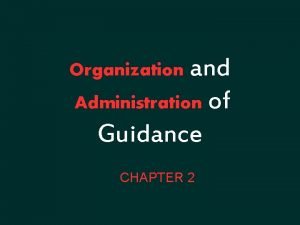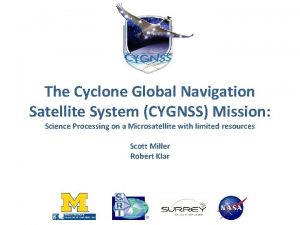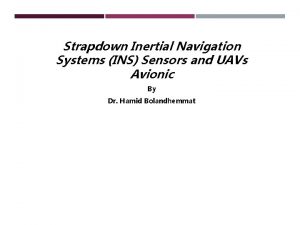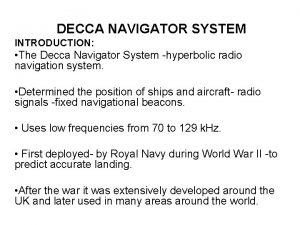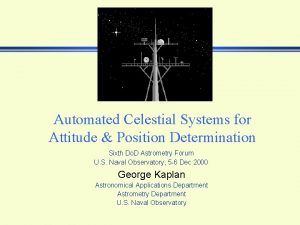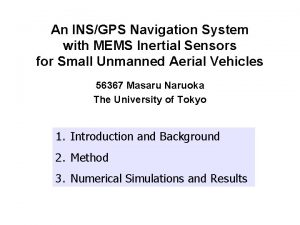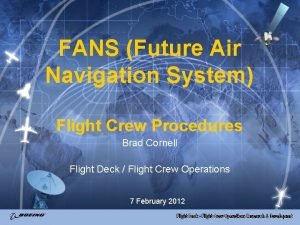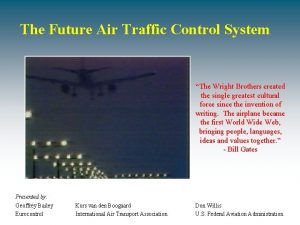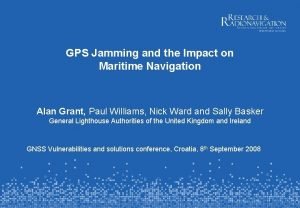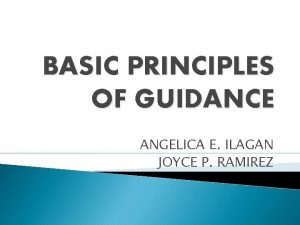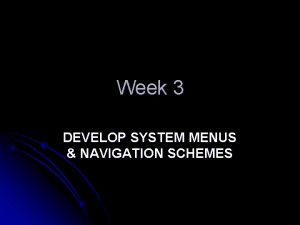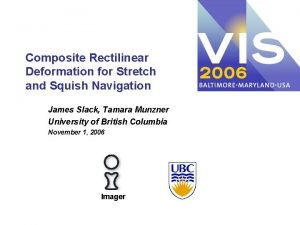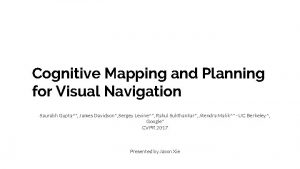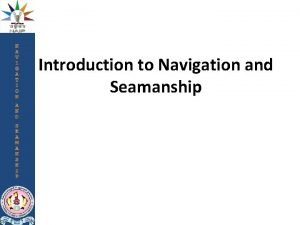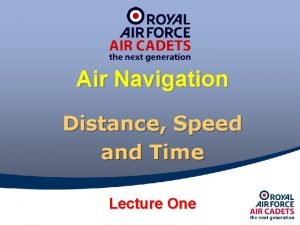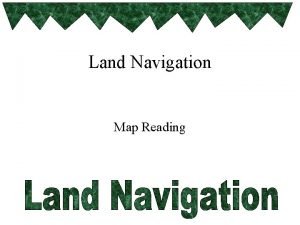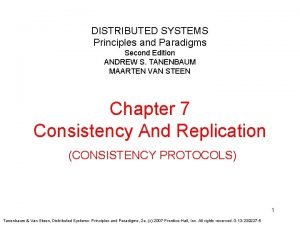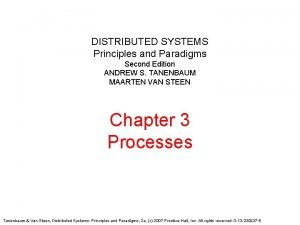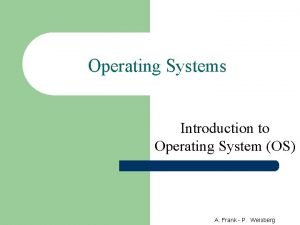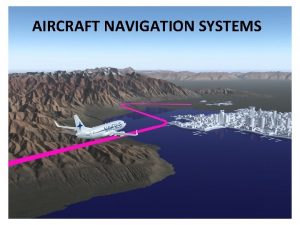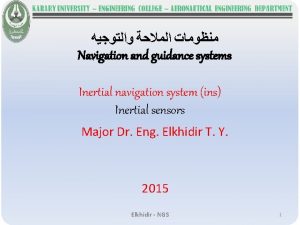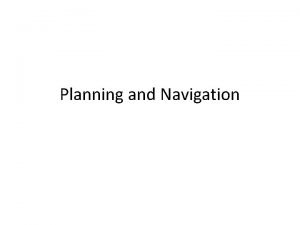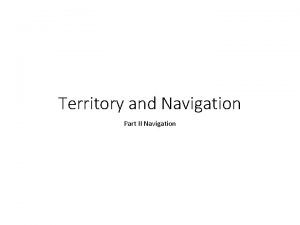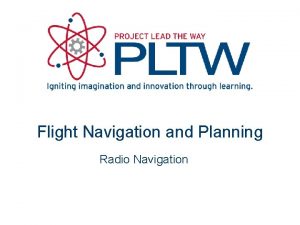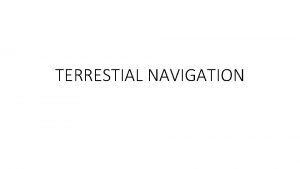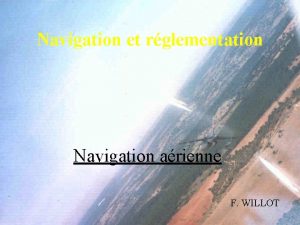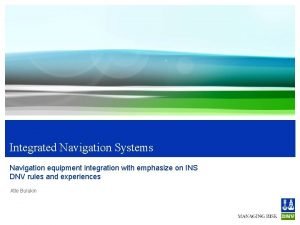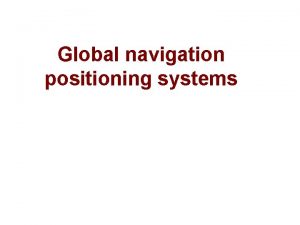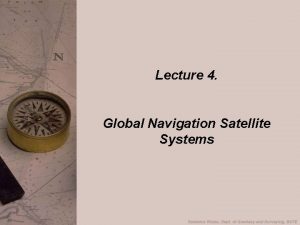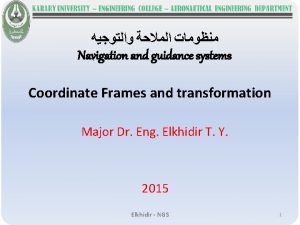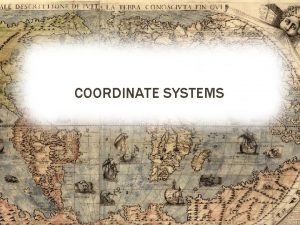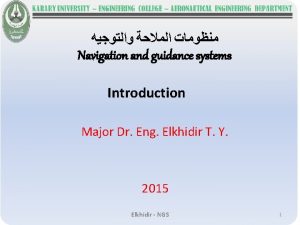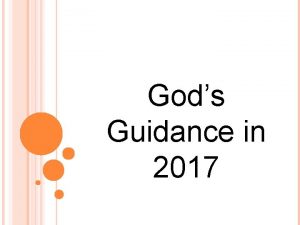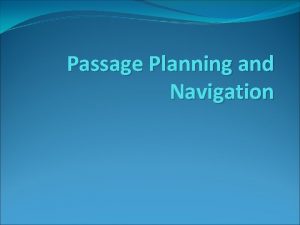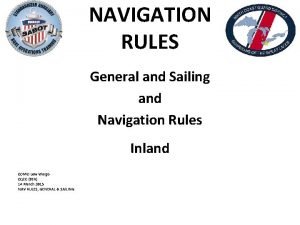Navigation and guidance systems Principles of guidance system






























- Slides: 30

ﻣﻨﻈﻮﻣﺎﺕ ﺍﻟﻤﻼﺣﺔ ﻭﺍﻟﺘﻮﺟﻴﻪ Navigation and guidance systems Principles of guidance system Major Dr. Eng. Elkhidir T. Y. 2015 Elkhidir - NGS 1

introduction Guidance • generally, it is the process of modifying a system (child, student, car, robot, aircraft, missile, etc. ) attitude in certain way to yield a desired performance. • is the process of calculating the changes in position, velocity, attitude, and/or rotation rates of a moving object required to follow a certain trajectory and/or attitude profile based on information about the object's state of motion. Guidance theory is concerned by: • explaining a set of phenomena in the field. • specifying key concepts, laws relating concepts. Elkhidir - NGS 2

introduction Field of guidance applications are: Children care, student education, trainee, management, leadership, automotive cars, robotics, aircrafts, missiles, etc. Guidance System can be defined as: • is a virtual or physical device, or a group of devices implementing a guidance process used for controlling the movement of a ship, aircraft, missile, rocket, satellite, or any other moving object. • a group of components that measures the position of the guided vehicle with respect to the target(s) and changes its flight path in accordance with a guidance law to achieve the flight mission goal. Elkhidir - NGS 3

introduction A guidance system is usually part of GNC system, whereas navigation refers to the systems necessary to calculate the current position and orientation based on sensor data like those from Compasses, GPS receivers, Loran-C, Star trackers, Inertial measurement units, Altimeters, etc. The output of the navigation system, the navigation solution, is an input for the guidance system, among others like the environmental conditions (wind, water, temperature, etc. ) and the vehicle's characteristics (i. e. mass, control system availability, control systems correlation to vector change, etc. ). Elkhidir - NGS 4

introduction In general, the guidance system computes the instructions for the control system, which comprises the object's actuators (e. g. , thrusters, reaction wheels, body flaps, etc. ), which are capable to manipulate the flight path and orientation of the object without direct or continuous human control. Usually, the missile guidance system includes sensing, computing, and control components, and the flight goal is to destroy a target. The UAV guidance system also includes an operator of a mission control unit, and targets may be dummy and generated by the operator to control the Elkhidir - NGS 5 vehicle’s flight.

introduction A guidance system has three major sub-sections: 1. Inputs: includes sensors, course data, radio and satellite links, and other information sources. 2. Processing: composed of one or more CPUs, integrates this data and determines what actions, if any, are necessary to maintain or achieve a proper heading. This is then fed to the outputs 3. Outputs: which can directly affect the system's course. The outputs may control speed by interacting with devices such as turbines, and fuel pumps, or they may more directly alter course by actuating ailerons, rudders, or other devices. Elkhidir - NGS 6

introduction Every guidance system consists of: 1. an attitude control system: its functions to maintain the object in the desired attitude on the ordered flight path by controlling the object in pitch, roll, and yaw. This system operates as an auto-pilot, damping out fluctuations that tend to deflect the object from its ordered flight path. 2. flight path control system: its function is to determine the flight path necessary for target interception and to generate the orders to the attitude control system to maintain that path. Elkhidir - NGS 7

Elkhidir - NGS 8

Guidance categories Missile guidance systems may be classified into two broad categories: Missiles guided by man-made electromagnetic devices: missiles controlled by radar, radio devices, and those missiles that use the target as a source of electromagnetic radiation. may be further subdivided into two subcategories. (1) Control guidance missiles (2) Homing guidance missiles Missiles guided by other means: missiles that rely on electromechanical devices or electromagnetic contact with natural sources, such as the stars (self-contained guidance systems). Elkhidir - NGS 9

Elkhidir - NGS 10

UAV guidance A guidance law is defined as an algorithm that determines the required commanded unmanned aerial vehicle acceleration. UAV guidance, navigation, and control (GNC) ultimately signifies the ability to follow a desired trajectory through the sky. To guide the UAV along the desired trajectory rejecting disturbances such as wind; we need to attitude estimation and inner loop stabilizing the aircraft Elkhidir - NGS 11

UAV guidance There are several ways to implement this guidance control. One way, deliver a mission to the UAV from the ground station, a simple set of GPS-based waypoints, along with an altitude and speed for each leg of the mission, is transmitted to the UAV via telemetry link. Furthermore, the interest is in flying the aircraft on the trajectory, and thus the legs are blended into each other using circular arcs rather than forcing the UAV to overfly each waypoint. Elkhidir - NGS 12

UAV guidance General tracking: The guidance algorithm used here is based on an extension of a simple line-of-sight guidance law originally developed for ground robotics. Much of the art of waypoint guidance consists of determining which leg of the trajectory the UAV is on and when to switch to the next leg of the trajectory. The basic approach is to define a Serret-Frenet frame which points from the current waypoint to the next ( T , along the current leg), with one axis down and the third defined by the cross product between the along track, T, and down, B, unit vectors. Elkhidir - NGS 13

UAV guidance The guidance algorithm steers the velocity vector toward the line of sight; this is one form of pursuit guidance. Making the commanded acceleration proportional to is only one of number of possible guidance laws. The basic guidance algorithm is to determine an aim point and steer the velocity vector toward it. Referring to Fig. below, Vg is the UAV’s ground speed, and C is a circular arc of radius R that originates at the UAV and intercepts the desired path. L 1 is a constant look-ahead distance from the UAV to the path in the desired direction of travel. Elkhidir - NGS 14

UAV guidance From elementary trigonometry: (1) Elkhidir - NGS 15

UAV guidance Additionally, from elementary kinematics, it is known that the centripetal acceleration, ac , required for a point mass to follow the circular arc C is given by: (2) Thus the UAV must command a lateral acceleration of ac. Solving equation (1) for R and substituting it into Eq. (2) produces the following control law for commanded acceleration: (3) Elkhidir - NGS 16

UAV guidance The only requirements for the implementation of this control law are to select the look ahead distance ( absolute of L 1) and determine sin(η), the sine of the angle from the velocity vector to L 1. η is sometimes called the line of sight angle. Choice of ( absolute of L 1) is analogous to feedback gain, with a larger L 1 corresponding to smaller gains; sin(η) is found from the vector cross product of Vg and L 1. (3) Elkhidir - NGS 17

UAV guidance For the UAV to actually track the desired trajectory, the lateral acceleration command must be converted to an appropriate bank angle command using the steady-state turn equation: (4) Elkhidir - NGS 18

UAV guidance Straight line tracking: The guidance algorithm is most easily described using a straight line. In Fig. below, the UAV is following a straight line segment from waypoint P 0 to P 1. A Serret-Frenet coordinate frame is attached to the initial waypoint, P 0, such that the calculations are always in local path coordinates. Elkhidir - NGS 19

UAV guidance Elkhidir - NGS 20

UAV guidance Elkhidir - NGS 21

UAV guidance which is then used in Eq. (3) to determine η and hence the commanded acceleration. For sufficiently small tracking errors, the L 1 guidance looks like a PD controller on lateral error. Elkhidir - NGS 22

UAV guidance Elkhidir - NGS 23

UAV guidance Elkhidir - NGS 24

UAV guidance Elkhidir - NGS 25

UAV guidance Elkhidir - NGS 26

UAV guidance The max operation ensures that the aim point does not extend beyond P 1, i. e. , if Da ever becomes negative due to UAV position or failure of the waypoint switching logic, the acceleration command is then computed by above equation, where the sin(η) is obtained from the cross product of Vg and Pa. Elkhidir - NGS 27

UAV guidance Note that when the aircraft is initially pointed in the opposite direction from T, η is greater 900. in this case, a maximum lateral acceleration is imposed to return the vehicle to correct flight path, where: and φmax is the maximum bank angle permitted. In order to use this controller in this condition, a maximum allowable η is required: Ucomm is commanded airspeed from the inner loop. Elkhidir - NGS 28

UAV guidance Elkhidir - NGS 29

Thank you Elkhidir - NGS 30
 Balanced occlusion formula
Balanced occlusion formula What is direct guidance
What is direct guidance Engineering elegant systems: theory of systems engineering
Engineering elegant systems: theory of systems engineering Difference between counselling and guidance
Difference between counselling and guidance Principles of organization and administration of guidance
Principles of organization and administration of guidance Cyclone global navigation satellite system
Cyclone global navigation satellite system Strapdown inertial navigation system
Strapdown inertial navigation system Decca system
Decca system Sr 71 star tracker
Sr 71 star tracker Mems inertial navigation system
Mems inertial navigation system Fans navigation
Fans navigation Future air navigation system
Future air navigation system Work strategies global navigation system jamming
Work strategies global navigation system jamming Basic principles of guidance
Basic principles of guidance Poseidon principles technical guidance
Poseidon principles technical guidance Principles of guidance
Principles of guidance Conclusion of counselling
Conclusion of counselling Principles of guidance
Principles of guidance Principles of guidance
Principles of guidance Computer assisted guidance systems
Computer assisted guidance systems New and navigation schemes selection of window
New and navigation schemes selection of window Stretch and squish navigation
Stretch and squish navigation Cognitive mapping and planning for visual navigation
Cognitive mapping and planning for visual navigation Navigation and seamanship
Navigation and seamanship Navigation using speed, distance and time calculations
Navigation using speed, distance and time calculations Basic map reading and land navigation
Basic map reading and land navigation Distributed systems andrew s tanenbaum
Distributed systems andrew s tanenbaum Distributed systems principles and paradigms
Distributed systems principles and paradigms Operating systems: internals and design principles
Operating systems: internals and design principles Operating systems: internals and design principles
Operating systems: internals and design principles Operating systems: internals and design principles
Operating systems: internals and design principles




